AT28BV256 EEPROMs: Pinout, Equivalent and Datasheet
Surface Mount Memory IC AT28BV256 256 kb kb 17.9mm mm 15mA mA
The AT28BV256 is a high-performance electrically erasable and programmable readonly memory. Its 256K of memory is organized as 32,768 words by 8 bits. Furthermore, Huge range of Semiconductors, Capacitors, Resistors and IcS in stock. Welcome RFQ.

Build an Arduino EEPROM programmer
AT28BV256 Pinout
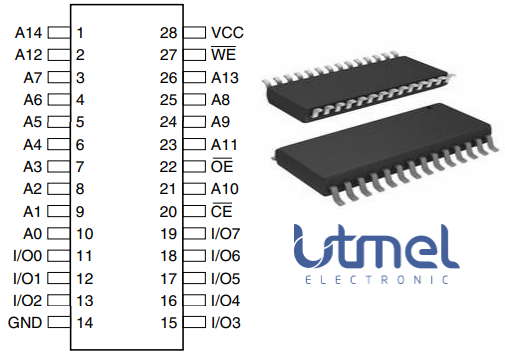
Pinout
AT28BV256 CAD Model

Footprint
AT28BV256 Overview
The AT28BV256 is a high-performance electrically erasable and programmable readonly memory. Its 256K of memory is organized as 32,768 words by 8 bits. Manufactured with Atmel's advanced nonvolatile CMOS technology, the device offers access times to 200 ns with power dissipation of just 54 mW. When the device is deselected, the CMOS standby current is less than 200 µA. The AT28BV256 is accessed like a Static RAM for the read or write cycle without the need for external components. The device contains a 64-byte page register to allow writing of up to 64 bytes simultaneously. During a write cycle, the addresses and 1 to 64 bytes of data are internally latched, freeing the address and data bus for other operations. Following the initiation of a write cycle, the device will automatically write the latched data using an internal control timer. The end of a write cycle can be detected by Data polling of I/O7. Once the end of a write cycle has been detected a new access for a read or write can begin.
This article provides you with a basic overview of the AT28BV256 EEPROMs, including its pin descriptions, features and specifications, etc., to help you quickly understand what AT28BV256 is.
AT28BV256 Features
● Single 2.7V - 3.6V Supply
● Fast Read Access Time – 200 ns
● Automatic Page Write Operation
◆ Internal Address and Data Latches for 64 Bytes
◆ Internal Control Timer
● Fast Write Cycle Times
◆ Page Write Cycle Time: 10 ms Maximum
◆ 1- to 64-byte Page Write Operation
● Low Power Dissipation
◆ 15 mA Active Current
◆ 20 µA CMOS Standby Current
● Hardware and Software Data Protection
● Data Polling for End of Write Detection
● High Reliability CMOS Technology
◆ Endurance: 10,000 Cycles
◆ Data Retention: 10 Years
● JEDEC Approved Byte-wide Pinout
● Industrial Temperature Ranges
● Green (Pb/Halide-free) Packaging Option Only
Specifications
- TypeParameter
- Factory Lead Time14 Weeks
- Contact Plating
Contact plating (finish) provides corrosion protection for base metals and optimizes the mechanical and electrical properties of the contact interfaces.
Tin - Mount
In electronic components, the term "Mount" typically refers to the method or process of physically attaching or fixing a component onto a circuit board or other electronic device. This can involve soldering, adhesive bonding, or other techniques to secure the component in place. The mounting process is crucial for ensuring proper electrical connections and mechanical stability within the electronic system. Different components may have specific mounting requirements based on their size, shape, and function, and manufacturers provide guidelines for proper mounting procedures to ensure optimal performance and reliability of the electronic device.
Surface Mount - Mounting Type
The "Mounting Type" in electronic components refers to the method used to attach or connect a component to a circuit board or other substrate, such as through-hole, surface-mount, or panel mount.
Surface Mount - Package / Case
refers to the protective housing that encases an electronic component, providing mechanical support, electrical connections, and thermal management.
28-SOIC (0.295, 7.50mm Width) - Number of Pins28
- Memory TypesNon-Volatile
- Operating Temperature
The operating temperature is the range of ambient temperature within which a power supply, or any other electrical equipment, operate in. This ranges from a minimum operating temperature, to a peak or maximum operating temperature, outside which, the power supply may fail.
-40°C~85°C TC - Packaging
Semiconductor package is a carrier / shell used to contain and cover one or more semiconductor components or integrated circuits. The material of the shell can be metal, plastic, glass or ceramic.
Tube - Published1997
- JESD-609 Code
The "JESD-609 Code" in electronic components refers to a standardized marking code that indicates the lead-free solder composition and finish of electronic components for compliance with environmental regulations.
e3 - Pbfree Code
The "Pbfree Code" parameter in electronic components refers to the code or marking used to indicate that the component is lead-free. Lead (Pb) is a toxic substance that has been widely used in electronic components for many years, but due to environmental concerns, there has been a shift towards lead-free alternatives. The Pbfree Code helps manufacturers and users easily identify components that do not contain lead, ensuring compliance with regulations and promoting environmentally friendly practices. It is important to pay attention to the Pbfree Code when selecting electronic components to ensure they meet the necessary requirements for lead-free applications.
yes - Part Status
Parts can have many statuses as they progress through the configuration, analysis, review, and approval stages.
Active - Moisture Sensitivity Level (MSL)
Moisture Sensitivity Level (MSL) is a standardized rating that indicates the susceptibility of electronic components, particularly semiconductors, to moisture-induced damage during storage and the soldering process, defining the allowable exposure time to ambient conditions before they require special handling or baking to prevent failures
2 (1 Year) - Number of Terminations28
- Additional Feature
Any Feature, including a modified Existing Feature, that is not an Existing Feature.
AUTOMATIC WRITE - Voltage - Supply
Voltage - Supply refers to the range of voltage levels that an electronic component or circuit is designed to operate with. It indicates the minimum and maximum supply voltage that can be applied for the device to function properly. Providing supply voltages outside this range can lead to malfunction, damage, or reduced performance. This parameter is critical for ensuring compatibility between different components in a circuit.
2.7V~3.6V - Terminal Position
In electronic components, the term "Terminal Position" refers to the physical location of the connection points on the component where external electrical connections can be made. These connection points, known as terminals, are typically used to attach wires, leads, or other components to the main body of the electronic component. The terminal position is important for ensuring proper connectivity and functionality of the component within a circuit. It is often specified in technical datasheets or component specifications to help designers and engineers understand how to properly integrate the component into their circuit designs.
DUAL - Peak Reflow Temperature (Cel)
Peak Reflow Temperature (Cel) is a parameter that specifies the maximum temperature at which an electronic component can be exposed during the reflow soldering process. Reflow soldering is a common method used to attach electronic components to a circuit board. The Peak Reflow Temperature is crucial because it ensures that the component is not damaged or degraded during the soldering process. Exceeding the specified Peak Reflow Temperature can lead to issues such as component failure, reduced performance, or even permanent damage to the component. It is important for manufacturers and assemblers to adhere to the recommended Peak Reflow Temperature to ensure the reliability and functionality of the electronic components.
250 - Number of Functions1
- Supply Voltage
Supply voltage refers to the electrical potential difference provided to an electronic component or circuit. It is crucial for the proper operation of devices, as it powers their functions and determines performance characteristics. The supply voltage must be within specified limits to ensure reliability and prevent damage to components. Different electronic devices have specific supply voltage requirements, which can vary widely depending on their design and intended application.
3V - Terminal Pitch
The center distance from one pole to the next.
1.27mm - Frequency
In electronic components, the parameter "Frequency" refers to the rate at which a signal oscillates or cycles within a given period of time. It is typically measured in Hertz (Hz) and represents how many times a signal completes a full cycle in one second. Frequency is a crucial aspect in electronic components as it determines the behavior and performance of various devices such as oscillators, filters, and communication systems. Understanding the frequency characteristics of components is essential for designing and analyzing electronic circuits to ensure proper functionality and compatibility with other components in a system.
5MHz - Time@Peak Reflow Temperature-Max (s)
Time@Peak Reflow Temperature-Max (s) refers to the maximum duration that an electronic component can be exposed to the peak reflow temperature during the soldering process, which is crucial for ensuring reliable solder joint formation without damaging the component.
40 - Base Part Number
The "Base Part Number" (BPN) in electronic components serves a similar purpose to the "Base Product Number." It refers to the primary identifier for a component that captures the essential characteristics shared by a group of similar components. The BPN provides a fundamental way to reference a family or series of components without specifying all the variations and specific details.
AT28BV256 - Operating Supply Voltage
The voltage level by which an electrical system is designated and to which certain operating characteristics of the system are related.
3.3V - Supply Voltage-Max (Vsup)
The parameter "Supply Voltage-Max (Vsup)" in electronic components refers to the maximum voltage that can be safely applied to the component without causing damage. It is an important specification to consider when designing or using electronic circuits to ensure the component operates within its safe operating limits. Exceeding the maximum supply voltage can lead to overheating, component failure, or even permanent damage. It is crucial to adhere to the specified maximum supply voltage to ensure the reliable and safe operation of the electronic component.
3.6V - Supply Voltage-Min (Vsup)
The parameter "Supply Voltage-Min (Vsup)" in electronic components refers to the minimum voltage level required for the component to operate within its specified performance range. This parameter indicates the lowest voltage that can be safely applied to the component without risking damage or malfunction. It is crucial to ensure that the supply voltage provided to the component meets or exceeds this minimum value to ensure proper functionality and reliability. Failure to adhere to the specified minimum supply voltage may result in erratic behavior, reduced performance, or even permanent damage to the component.
2.7V - Memory Size
The memory capacity is the amount of data a device can store at any given time in its memory.
256Kb 32K x 8 - Nominal Supply Current
Nominal current is the same as the rated current. It is the current drawn by the motor while delivering rated mechanical output at its shaft.
15mA - Access Time
Access time in electronic components refers to the amount of time it takes for a system to retrieve data from memory or storage once a request has been made. It is typically measured in nanoseconds or microseconds and indicates the speed at which data can be accessed. Lower access time values signify faster performance, allowing for more efficient processing in computing systems. Access time is a critical parameter in determining the overall responsiveness of electronic devices, particularly in applications requiring quick data retrieval.
200ns - Memory Format
Memory Format in electronic components refers to the specific organization and structure of data storage within a memory device. It defines how data is stored, accessed, and managed within the memory module. Different memory formats include RAM (Random Access Memory), ROM (Read-Only Memory), and various types of flash memory. The memory format determines the speed, capacity, and functionality of the memory device, and it is crucial for compatibility with other components in a system. Understanding the memory format is essential for selecting the right memory module for a particular application or device.
EEPROM - Memory Interface
An external memory interface is a bus protocol for communication from an integrated circuit, such as a microprocessor, to an external memory device located on a circuit board.
Parallel - Organization
In the context of electronic components, the parameter "Organization" typically refers to the arrangement or structure of the internal components within a device or system. It can describe how various elements such as transistors, resistors, capacitors, and other components are physically arranged and interconnected on a circuit board or within a semiconductor chip.The organization of electronic components plays a crucial role in determining the functionality, performance, and efficiency of a device. It can impact factors such as signal propagation, power consumption, thermal management, and overall system complexity. Engineers carefully design the organization of components to optimize the operation of electronic devices and ensure reliable performance.Different types of electronic components may have specific organizational requirements based on the intended application and design considerations. For example, integrated circuits may have a highly compact and intricate organization to maximize functionality within a small footprint, while larger electronic systems may have a more modular and distributed organization to facilitate maintenance and scalability.
32KX8 - Memory Width
Memory width refers to the number of bits that can be read or written to memory at one time. It is an important specification in electronic components, particularly in memory devices like RAM and cache. A wider memory width allows for greater data throughput, enabling faster performance as more data can be processed simultaneously. Memory width can vary among different types of memory and can impact both the complexity and efficiency of data handling within electronic systems.
8 - Write Cycle Time - Word, Page
Write Cycle Time - Word, Page refers to the duration required to write data to a specific memory cell or a page of memory in electronic components, particularly in non-volatile memories like Flash or EEPROM. It indicates the time taken to complete a writing operation for a single word or an entire page of data. This parameter is crucial for determining the performance and speed of memory devices in applications where quick data storage is essential. It impacts the overall efficiency in data handling, affecting both read and write speeds in memory-related operations.
10ms - Density
In electronic components, "Density" refers to the mass or weight of a material per unit volume. It is a physical property that indicates how tightly packed the atoms or molecules are within the material. The density of a component can affect its performance and characteristics, such as its strength, thermal conductivity, and electrical properties. Understanding the density of electronic components is important for designing and manufacturing processes to ensure optimal performance and reliability.
256 kb - Standby Current-Max
Standby Current-Max refers to the maximum amount of current that an electronic component or device consumes while in a low-power standby mode. This parameter is critical for power management, especially in battery-operated devices, as it indicates how efficiently the device can conserve energy when not actively in use. A lower Standby Current-Max value is typically desirable, as it contributes to longer battery life and reduced energy consumption. Manufacturers specify this value to help engineers select components that meet specific power efficiency requirements in their designs.
0.00002A - Programming Voltage
A special high-voltage supply that supplies the potential and energy for altering the state of certain nonvolatile memory arrays. On some devices, the presence of VPP also acts as a program enable signal (P).
3V - Endurance
In electronic components, "Endurance" refers to the ability of a component to withstand repeated cycles of operation without degradation in performance or failure. It is a crucial parameter, especially in components that are subjected to frequent switching or high levels of stress during operation. Endurance testing is often conducted to evaluate the reliability and durability of electronic components under real-world conditions. Components with high endurance ratings are more likely to have a longer lifespan and provide consistent performance over time. Manufacturers typically provide endurance specifications in datasheets to help engineers and designers select components that meet the required durability for their applications.
10000 Write/Erase Cycles - Write Cycle Time-Max (tWC)
The parameter "Write Cycle Time-Max (tWC)" in electronic components refers to the maximum amount of time it takes for data to be written to a memory cell or storage device. It is a crucial specification in devices such as EEPROMs, flash memory, and other non-volatile memory technologies. The tWC value indicates the longest duration required for a write operation to be completed successfully, ensuring that the data is stored accurately and reliably. Designers and engineers use this parameter to optimize performance and ensure proper functioning of the electronic component within the specified time constraints.
10ms - Data Retention Time-Min
The parameter "Data Retention Time-Min" in electronic components refers to the minimum amount of time that data can be stored in a non-volatile memory device without requiring a refresh or rewrite operation to maintain its integrity. This parameter is crucial for applications where data integrity and reliability are essential, such as in embedded systems, IoT devices, and critical infrastructure. A longer data retention time indicates a more stable memory device that can retain data for extended periods without degradation or loss. It is important to consider the data retention time when selecting memory components for specific applications to ensure data reliability and longevity.
10 - Write Protection
Write protection is a feature found in electronic components, such as memory devices, that prevents data from being modified or erased. When write protection is enabled, the data stored in the component is locked and cannot be altered, ensuring the integrity and security of the information. This feature is commonly used in devices like USB flash drives, SD cards, and EEPROMs to prevent accidental data loss or unauthorized access. Write protection can be implemented through hardware mechanisms, such as physical switches or jumpers, or through software settings that restrict write access to the component.
HARDWARE/SOFTWARE - Data Polling
Data Polling is a process used in electronic components to retrieve data at regular intervals from a sensor or device. It involves checking or querying the device for updated information, ensuring that the most current data is accessible for processing or analysis. This technique is commonly used in systems where continuous monitoring is necessary, allowing for timely responses based on the latest data collected. Data Polling can impact system performance, as it may introduce delays or consume resources depending on the polling frequency and the efficiency of the implemented protocol.
YES - Toggle Bit
The toggle bit is a control mechanism in electronic components that allows a circuit to switch between two states, typically representing binary values of 0 and 1. It is commonly used in digital systems to change the status of a device or memory cell each time it is activated. The toggle bit maintains its state until it receives a new signal that alters its value, making it essential for operations such as counters and flip-flops. This functionality enables efficient data storage, retrieval, and manipulation in various electronic applications.
YES - Command User Interface
The term "Command User Interface" in electronic components refers to the method by which a user interacts with a device or system through issuing commands. This interface allows users to input instructions or requests to control the operation of the electronic component. The Command User Interface can take various forms, such as physical buttons, touchscreens, voice commands, or software-based interfaces. It plays a crucial role in enabling users to interact with and utilize the functionalities of electronic components effectively. The design and implementation of a Command User Interface are essential considerations in ensuring user-friendly and intuitive operation of electronic devices.
NO - Page Size
In electronic components, "Page Size" refers to the amount of data that can be stored or accessed in a single page of memory. It is a crucial parameter in memory devices such as flash memory, where data is organized into pages for efficient reading and writing operations. The page size determines the granularity at which data can be written or read from the memory, impacting the speed and efficiency of data transfers. Choosing the appropriate page size is important for optimizing performance and storage capacity in electronic devices.
64words - Length17.9mm
- Height Seated (Max)
Height Seated (Max) is a parameter in electronic components that refers to the maximum allowable height of the component when it is properly seated or installed on a circuit board or within an enclosure. This specification is crucial for ensuring proper fit and alignment within the overall system design. Exceeding the maximum seated height can lead to mechanical interference, electrical shorts, or other issues that may impact the performance and reliability of the electronic device. Manufacturers provide this information to help designers and engineers select components that will fit within the designated space and function correctly in the intended application.
2.65mm - Width7.5mm
- REACH SVHC
The parameter "REACH SVHC" in electronic components refers to the compliance with the Registration, Evaluation, Authorization, and Restriction of Chemicals (REACH) regulation regarding Substances of Very High Concern (SVHC). SVHCs are substances that may have serious effects on human health or the environment, and their use is regulated under REACH to ensure their safe handling and minimize their impact.Manufacturers of electronic components need to declare if their products contain any SVHCs above a certain threshold concentration and provide information on the safe use of these substances. This information allows customers to make informed decisions about the potential risks associated with using the components and take appropriate measures to mitigate any hazards.Ensuring compliance with REACH SVHC requirements is essential for electronics manufacturers to meet regulatory standards, protect human health and the environment, and maintain transparency in their supply chain. It also demonstrates a commitment to sustainability and responsible manufacturing practices in the electronics industry.
No SVHC - Radiation Hardening
Radiation hardening is the process of making electronic components and circuits resistant to damage or malfunction caused by high levels of ionizing radiation, especially for environments in outer space (especially beyond the low Earth orbit), around nuclear reactors and particle accelerators, or during nuclear accidents or nuclear warfare.
No - RoHS Status
RoHS means “Restriction of Certain Hazardous Substances” in the “Hazardous Substances Directive” in electrical and electronic equipment.
ROHS3 Compliant - Lead Free
Lead Free is a term used to describe electronic components that do not contain lead as part of their composition. Lead is a toxic material that can have harmful effects on human health and the environment, so the electronics industry has been moving towards lead-free components to reduce these risks. Lead-free components are typically made using alternative materials such as silver, copper, and tin. Manufacturers must comply with regulations such as the Restriction of Hazardous Substances (RoHS) directive to ensure that their products are lead-free and environmentally friendly.
Lead Free
AT28BV256 Functional Block Diagram
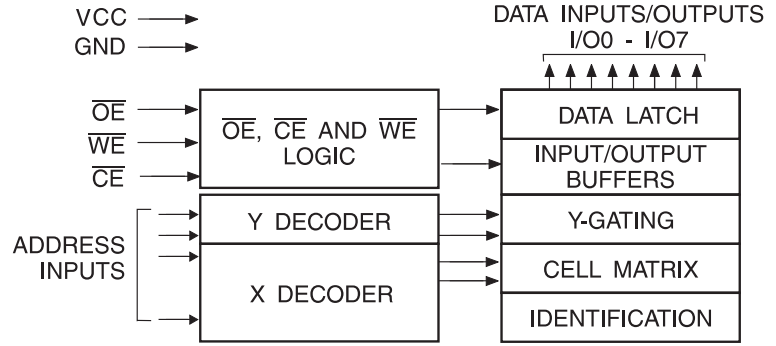
Block Diagram
AT28BV256 Equivalent
| Model number | Manufacturer | Description |
| HN58V256AFP-12 | Hitachi Ltd | EEPROM, 32KX8, 120ns, Parallel, CMOS, PDSO28, 0.400 INCH, PLASTIC, SOP-28 |
| M28256-20WMS6T | STMicroelectronics | 32KX8 EEPROM 3V, 200ns, PDSO28, 0.300 INCH, PLASTIC, SO-28 |
| M28256-20WMS3 | STMicroelectronics | 32KX8 EEPROM 3V, 200ns, PDSO28, 0.300 INCH, PLASTIC, SO-28 |
| M28256-15WMS3T | STMicroelectronics | 32KX8 EEPROM 3V, 150ns, PDSO28, 0.300 INCH, PLASTIC, SO-28 |
| AT28LV256-25SI | Atmel Corporation | EEPROM, 32KX8, 250ns, Parallel, CMOS, PDSO28, 0.300 INCH, PLASTIC, SOIC-28 |
| M28256-90WMS1 | STMicroelectronics | 32KX8 EEPROM 3V, 90ns, PDSO28, 0.300 INCH, PLASTIC, SO-28 |
| AT28LV256-20SC | Atmel Corporation | EEPROM, 32KX8, 200ns, Parallel, CMOS, PDSO28, 0.300 INCH, PLASTIC, SOIC-28 |
| AT28LV256-20SCT/R | Atmel Corporation | EEPROM, 32KX8, 200ns, Parallel, CMOS, PDSO28, 0.300 INCH, PLASTIC, SOIC-28 |
| M28256-15WMS6 | STMicroelectronics | 32KX8 EEPROM 3V, 150ns, PDSO28, 0.300 INCH, PLASTIC, SO-28 |
| AT28LV256-30SCT/R | Atmel Corporation | EEPROM, 32KX8, 300ns, Parallel, CMOS, PDSO28, 0.300 INCH, PLASTIC, SOIC-28 |
Parts with Similar Specs
- ImagePart NumberManufacturerPackage / CaseNumber of PinsDensityAccess TimeFrequencySupply VoltageWrite Cycle Time - Word, PageTime@Peak Reflow Temperature-Max (s)View Compare
AT28BV256-20SU
28-SOIC (0.295, 7.50mm Width)
28
256 kb
200ns
5 MHz
3 V
10ms
40
28-SOIC (0.295, 7.50mm Width)
28
256 kb
120ns
5 MHz
5 V
10ms
40
28-SOIC (0.295, 7.50mm Width)
28
256 kb
150ns
150 GHz
5 V
10ms
40
28-SOIC (0.295, 7.50mm Width)
28
256 kb
150ns
5 MHz
5 V
10ms
40
AT28BV256 Package
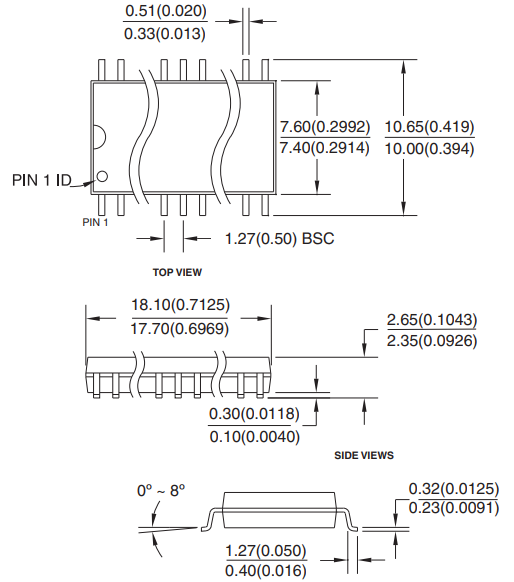
Package
AT28BV256 Manufacturer
Microchip Technology Inc. is a leading provider of microcontroller and analog semiconductors, providing low-risk product development, lower total system cost and faster time to market for thousands of diverse customer applications worldwide. Headquartered in Chandler, Arizona, Microchip offers outstanding technical support along with dependable delivery and quality.
Trend Analysis
Datasheet PDF
- Datasheets :
- PCN Design/Specification :
- PCN Packaging :
- ConflictMineralStatement :
What is the essential property of the AT28BV256?
The AT28BV256 is a high-performance electrically erasable and programmable readonly memory. Its 256K of memory is organized as 32,768 words by 8 bits.
Do external components need to access AT28BV256 in the read/write cycle?
The AT28BV256 is accessed like a Static RAM for the read or write cycle without the need for external components. The device contains a 64-byte page register to allow writing of up to 64 bytes simultaneously.
 AD8602 Amplifier Guide: Features, Applications & Benefits
AD8602 Amplifier Guide: Features, Applications & Benefits03 July 2025119
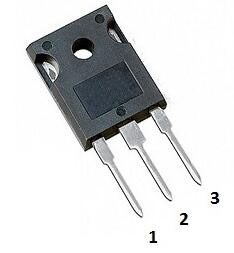 2SC5198 NPN Transistor: Replacement, Circuit and Datasheet
2SC5198 NPN Transistor: Replacement, Circuit and Datasheet23 October 20216508
 2SK3878 Field Effect Transistor: Equivalent, Datasheet and Diagram
2SK3878 Field Effect Transistor: Equivalent, Datasheet and Diagram24 February 202212247
![39-01-2040 Receptacle Housing Dual Row 4 Circuits [FAQ]:Datasheet, Applications, and Technical Data](https://res.utmel.com/Images/Article/cbccf151-74f5-443a-a951-343628aa422c.jpg) 39-01-2040 Receptacle Housing Dual Row 4 Circuits [FAQ]:Datasheet, Applications, and Technical Data
39-01-2040 Receptacle Housing Dual Row 4 Circuits [FAQ]:Datasheet, Applications, and Technical Data22 March 2022651
 ATmega16 Microcontroller: Datasheet, Pinout and Alternatives
ATmega16 Microcontroller: Datasheet, Pinout and Alternatives16 July 20217820
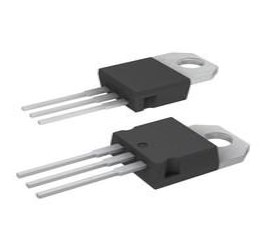 L78S05CV: 35V, Heatsink, Pinout and Datasheet
L78S05CV: 35V, Heatsink, Pinout and Datasheet24 February 20221124
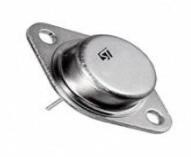 LM323K Voltage Regulator: LM323K, Datasheet, Pinout, Equivalent
LM323K Voltage Regulator: LM323K, Datasheet, Pinout, Equivalent31 December 20214222
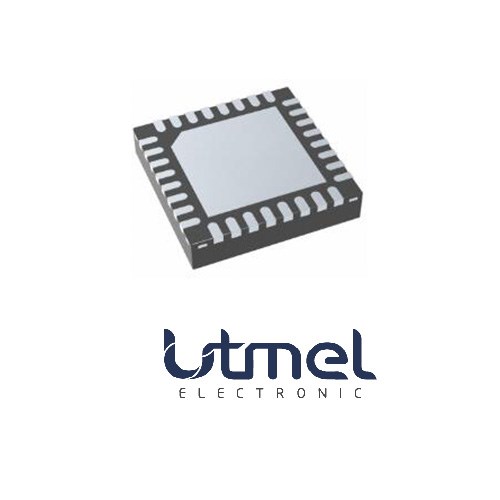 TLC59116IRHBR 16-Channel LED Driver: Features and Datasheet
TLC59116IRHBR 16-Channel LED Driver: Features and Datasheet24 March 2022436
 Bridge Rectifier: Functions, Circuits and Applications
Bridge Rectifier: Functions, Circuits and Applications03 November 202012728
 Introduction to Temperature Sensors
Introduction to Temperature Sensors24 October 20258240
 Function and Application of Laser Sensors
Function and Application of Laser Sensors28 October 20256957
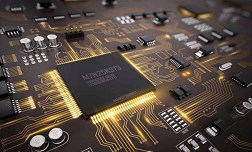 What is inductor: Symbol, Applications and Types
What is inductor: Symbol, Applications and Types04 January 20228463
 How to Properly Install TVS Diodes in Your PCB Design
How to Properly Install TVS Diodes in Your PCB Design11 July 20251366
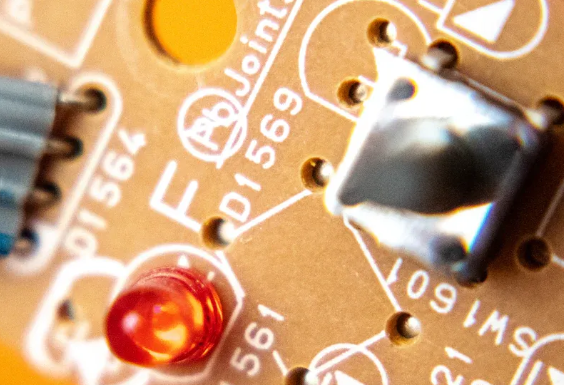 How 10k Resistor Color Code Stacks Up Against 220 and 100k
How 10k Resistor Color Code Stacks Up Against 220 and 100k03 September 2025632
 The Underappreciated iphone - No One Believed Apple CEO Steve Jobs Would Succeed Before
The Underappreciated iphone - No One Believed Apple CEO Steve Jobs Would Succeed Before01 July 20222750
 Detailed Explanation of MOSFET
Detailed Explanation of MOSFET12 March 202215307
Microchip Technology
In Stock: 81
United States
China
Canada
Japan
Russia
Germany
United Kingdom
Singapore
Italy
Hong Kong(China)
Taiwan(China)
France
Korea
Mexico
Netherlands
Malaysia
Austria
Spain
Switzerland
Poland
Thailand
Vietnam
India
United Arab Emirates
Afghanistan
Åland Islands
Albania
Algeria
American Samoa
Andorra
Angola
Anguilla
Antigua & Barbuda
Argentina
Armenia
Aruba
Australia
Azerbaijan
Bahamas
Bahrain
Bangladesh
Barbados
Belarus
Belgium
Belize
Benin
Bermuda
Bhutan
Bolivia
Bonaire, Sint Eustatius and Saba
Bosnia & Herzegovina
Botswana
Brazil
British Indian Ocean Territory
British Virgin Islands
Brunei
Bulgaria
Burkina Faso
Burundi
Cabo Verde
Cambodia
Cameroon
Cayman Islands
Central African Republic
Chad
Chile
Christmas Island
Cocos (Keeling) Islands
Colombia
Comoros
Congo
Congo (DRC)
Cook Islands
Costa Rica
Côte d’Ivoire
Croatia
Cuba
Curaçao
Cyprus
Czechia
Denmark
Djibouti
Dominica
Dominican Republic
Ecuador
Egypt
El Salvador
Equatorial Guinea
Eritrea
Estonia
Eswatini
Ethiopia
Falkland Islands
Faroe Islands
Fiji
Finland
French Guiana
French Polynesia
Gabon
Gambia
Georgia
Ghana
Gibraltar
Greece
Greenland
Grenada
Guadeloupe
Guam
Guatemala
Guernsey
Guinea
Guinea-Bissau
Guyana
Haiti
Honduras
Hungary
Iceland
Indonesia
Iran
Iraq
Ireland
Isle of Man
Israel
Jamaica
Jersey
Jordan
Kazakhstan
Kenya
Kiribati
Kosovo
Kuwait
Kyrgyzstan
Laos
Latvia
Lebanon
Lesotho
Liberia
Libya
Liechtenstein
Lithuania
Luxembourg
Macao(China)
Madagascar
Malawi
Maldives
Mali
Malta
Marshall Islands
Martinique
Mauritania
Mauritius
Mayotte
Micronesia
Moldova
Monaco
Mongolia
Montenegro
Montserrat
Morocco
Mozambique
Myanmar
Namibia
Nauru
Nepal
New Caledonia
New Zealand
Nicaragua
Niger
Nigeria
Niue
Norfolk Island
North Korea
North Macedonia
Northern Mariana Islands
Norway
Oman
Pakistan
Palau
Palestinian Authority
Panama
Papua New Guinea
Paraguay
Peru
Philippines
Pitcairn Islands
Portugal
Puerto Rico
Qatar
Réunion
Romania
Rwanda
Samoa
San Marino
São Tomé & Príncipe
Saudi Arabia
Senegal
Serbia
Seychelles
Sierra Leone
Sint Maarten
Slovakia
Slovenia
Solomon Islands
Somalia
South Africa
South Sudan
Sri Lanka
St Helena, Ascension, Tristan da Cunha
St. Barthélemy
St. Kitts & Nevis
St. Lucia
St. Martin
St. Pierre & Miquelon
St. Vincent & Grenadines
Sudan
Suriname
Svalbard & Jan Mayen
Sweden
Syria
Tajikistan
Tanzania
Timor-Leste
Togo
Tokelau
Tonga
Trinidad & Tobago
Tunisia
Turkey
Turkmenistan
Turks & Caicos Islands
Tuvalu
U.S. Outlying Islands
U.S. Virgin Islands
Uganda
Ukraine
Uruguay
Uzbekistan
Vanuatu
Vatican City
Venezuela
Wallis & Futuna
Yemen
Zambia
Zimbabwe
















